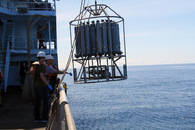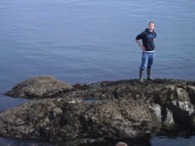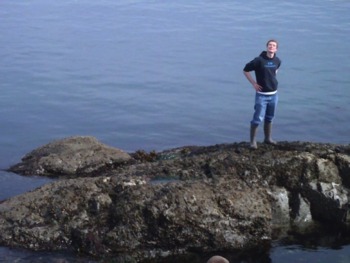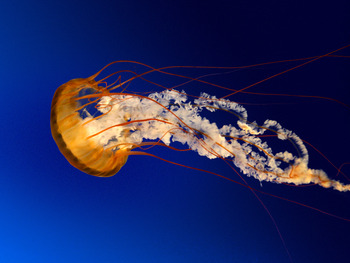Cody Turner
Last Entry
Tuesday, August 30, 2011
These last few days have kind of run together. I finally finished compiling all my data for my presentation. I will be giving the presentation tomorrow morning. It will only last around 10 minutes, and I’ve heard that it is fairly informal. Last night starting at midnight there was an exploration dive in a new vent field found on this cruise. Alden Denny was the dive planner and he made all the decisions concerning where to go. He is only 25, so this was a really good experience for him. There was a 50 meter tall vent found, that the cable goes straight over. We are currently transiting back, and going to Victoria B.C. first. It’s a fairly bumpy ride, but fortunately I’m not feeling seasick at all. Getting back to land is going to be strange. I don’t know if I will be able to fall asleep, now that I am used to the rocking of the boat, and I’ve heard that people sometimes get landsick. It will be nice to see everyone again. Also, I am going to have to cook for myself again! I don’t think I will be eating as much when I get back as I have been on the cruise. The food here is phenomenal.
I have a lot of samples and research to take care of when I get back. It is really cool to have my own project started, especially one that I can continue for pretty much as long as I want. I am looking forward to seeing what happens with all the data everyone has compiled from this cruise, and to see where my own data leads me. I have had a truly amazing experience these last three weeks, and I have learned so much. I hope there will be many more research cruises in my future. Thanks to everyone who has been reading these, and I hope you have enjoyed reading about what I have been doing.
Cody Turner
Entry 11
Sunday, August 28, 2011
Today and yesterday were very full days. Yesterday, I listened to two talks given by different professors. Both of them were really interesting, and would have normally given a talk like that to hundreds of people, instead of me and 6 or 7 other undergrads. The first talk was given by Tim Crone, a professor at Columbia. He was one of the first people to successfully measure the flow of the BP oil spill a year ago. His talk was about how it was doing science in the spotlight of media and major corporations. The second talk was given by Dr. Cody Youngbull, a physics professor at Arizona State. He is designing and buliding sensor robots that will measure different oceanographic properties on the seafloor.
Besides talks, I have been working hard to finish my cell counts for my reserach project. I finally finished last night, around 2 a.m. Now I have to make a presentation for August 31, and take more samples with the CTD casts. I will also be giving a small tutorial on how to make mosaics from the images obtained from the HD video on the cruise. This will be shown to a class in South Carolina.
Entry 10
Friday, August 26, 2011
Today was a really amazing day. I learned how to count cells using the dapi software from Dr. Bob Morris, and got to work going through and counting all the slides I have. At around 3, the students drew straws to decide who got to go out on the rescue boat. I didn't get it at first, so I went back to counting my cells. Then Bob came back and told me there was another drawing, and that he had drawn for me and won! So, I got to go out and cruise around in the rescue boat while a bunch of people took photos. The rescue boat is let down to the water by a giant lift on the side of the Thompson, with all the poeple inside. It was awesome to get a water-level perspective of the Thompson, and to be so close to the water with the long rolling ocean waves. It was definitely one of the highlights of the cruise so far.
Entry 9
Thursday, August 25, 2011
We saw hydrothermal vents yesterday! After doing two kinds of mosaics of these vents in photoshop for so long, I finally got to see one. I had seen video footage of them before, but it's not at all the same as watching it while in the same area. I even recognized some of the individual vents from the mosaics. On a different note, I have decided that Vashon Island is strangely well known for how obscure of a place it is. I was wearing a Vashon Crew shirt, and one of the guys from the ROPOS team noticed. Apparently one the ROPOS navigators is from Vashon. That came as a pretty big surprise.
I have taken more samples from two more CTD casts, but I don't know if there are enough filters to do cell counts on the ship. I am probably going to wait until I get back to UW to finish getting the data for my research. I still have to use the dapi software to do my cell counts for the samples I do have, and then I have to put together a presentation for the end of the cruise. All of this should definitely keep me busy for the rest of the cruise.
Entry 8
Tuesday, August 23, 2011
Last night, the stars were incredible. The Milky Way was even visible. I sat out there for a while, and watched as my night vision got better. It was really an amazing night. Today I worked on preserving my microbial samples for a cell count. There is a fairly extensive procedure for this, and it took me a long time. I have one more step to do, then I can count the amount of cells using a computer program called dapi. Life on sea is still a lot of fun. I could get used to eating as much food as I want, and getting rocked to sleep by the waves every night. My watch was very exciting today too. ROPOS was going through a possible sight for laying the undersea cable, which was recently covered by lava from an undersea eruption. It was so cool to see how the lava cooled and formed quickly on the sea floor. If you are reading this and haven't seen the footage, you should watch the live feed from the VISIONS website. The lava flows have created some unbelievable structures. Hopefully I can see more later!
Entry 7
Monday, August 22, 2011
Yesterday and today have been pretty steady. There is a fair amount of work for me to do, but enough time off for me to sleep a fair amount. My watch changed from 4-8 PM instead of AM, which is really nice. My job for the watch also changed. Instead of logging important events of the ROPOS dives, I am controlling the iris of the HD camera on board. Basically I set the brightness of the camera so it isn't too far white or black. FOr my project, I am now filtering my microbiology samples, so that I can do a cell count with a microscope soon. We still have a fair amount of CTD casts to do during the trip, so I have a lot of work left. At the end of the cruise, I am going to give a short presentation of the work I've been doing. Yesterday night we saw a very rare octopus, which was living about 2300 meters deep.
Entry 6
Saturday, August 20, 2011
Yesterday and today were much more relaxed. We got into Newport yesterday, ending Leg 1 and starting Leg 2. We dropped some people off and pick others up. Then we headed out to Axial Seamount. It's pretty far away (about 300 km) so we have been travelling since yesterday at around 4:30 PM. We have made some stops for CTD casts and surveyed the bottom a few times with the EM 302. I've been helping out where I can, but it hasn't been near as intense as the end of Leg 1. I don't need any samples from the CTD casts we are doing out here, because there aren't any methane plumes. When we get to Axial Seamount, however, we should start seeing methane plumes, and I should start to have a lot more work to do.
Entry 5
Thursday, August 18, 2011
Yesterday wa a very long day. However, it was still a lot of fun, and I learned quite a lot. I started out at about 10:30 collecting samples for the gas chromatograph and for my microbial samples. After a break for lunch I learned how to check the mosaics that were being made from the ROPOS dive. Then I did more oxygen titrations until a break for dinner at around 5:30. I finished the oxygen titrations after dinner, and then worked checking the mosaics from 8-12. I got to sleep around 12:30, and then woke up at 3:30 for my watch from 4-8. I didn't think I would do too well with only 3 hours of sleep, but it's not that bad at all. I have about 4 more hours of work with checking the mosaics, and then I will probably take a nap around noon. After that I don't have anything to do until 8 that night, and then we are transiting to Newport.
Entry 4
Wednesday, August 17, 2011
Yesterday was quite a full day. At 3, I did oxygen titrations with Orest Kawka from the CTD cast until dinner at 5. After dinner, I watched the dive as they discovered a huge methane seep in on the sea floor about 770 meters down. Then I did some work with Giora Prokurowski using the gas chromatograph, setting standards for the samples we ran later that night. When ROPOS finished the dive, we gathered the samples from the Niskin bottles they had on the ROV. I also gathered samples for the microbiology portion of my project from the ROPOS dive. Another CTD cast was done after the ROPOS dive. We collected more samples for the gas chromatograph from the CTD cast, and I collected more samples for my microbiology portion. After that, Giora and I ran the samples through the gas chromatograph, and then I preserved my microbiology samples with formaldehyde. I finished all that around 12:30 in the morning. I got up at 7 for breakfast, and later I will be helping Mitch Elend work with a ROPOS dive based on mosaicing. A great part of this cruise has been the food. The food on board is really incredible, and there is so much of it for every meal that I can eat as much as I want. Another really cool aspect of the cruises are the sunsets and sunrises. Since it has been almost completely clear these past few days, the sunsets and rises are phenomenal.

Entry 3
Tuesday, August 16, 2011
Yesterday, I helped with the CTD cast. I put on safety gear, helped guide the rosette out into the water, and watched as the profiles of the different properties (like temperature, salinity, fluorescence, ect.) versus depth were formed. When the CTD came back up, some other people and I collected water samples to measure oxygen concentration. I woke up at 4 again, but instead of standing watch for a ROPOS dive I ran an EM 302 survey of the water column looking for bubble plumes. The EM 302 basically detects disturbances in the water column, which can be created by many different things, including bubble plumes. It was interesting to see how such a complicated looking program worked, and I got to catch a glance of an incredible sunrise at sea. It's still very sunny outside, which is wonderful. Tonight there is going to be some coring done, meaning I get to play in the mud. Woohoo!
Entry 2
Monday, August 15, 2011
I woke up today at 3:45 in the morning for my watch, which was amazing. It was really cool to see the ROPOS operators at work, and how they all work together so well. Yesterday, I learned the basics of how to use a Gas Chromatograph, which tells you the concentration of each gas in a sample. That took about 2 hours. The GC is a really useful machine, but it has a lot of intricacies that it seems will take a while to fully understand. Today we are doing a CTD cast, and some more dives. The weather has been incredible so far, clear skies and calm seas, and hopefully it will stay that way!
Entry 1
Saturday, August 13, 2011
So far, this research cruise has been both educational and fun. It is interesting to see how operations are run on the Thompson, and how the engineers, scientists, and the crew of the Thompson all work together. It was especially cool to see how the operators of the ROV are able to control the vehicle so precisely. We just sailed into open ocean today, and the waves are fairly calm so I haven’t felt seasick at all (woohoo!). I will be starting my research as soon as we reach Hydrate Ridge. As of now, I will be taking water samples from the CTD casts, and analyzing them using a gas chromatograph to determine the concentration of methane and a microscope to determine how many and what kind of microbes are in the samples. I will also look at data given by the EM 302, which gives a general idea of the size and shape of a bubble plume. All this is to examine the relationship between methane in bubble plumes and the microbiology within the water column.

Cody Turner
Sunday, January 01, 2006
My name is Cody Turner, and I am currently a junior at the University of Washington. I am majoring in oceanography and biology, with a minor in marine biology. I grew up on Vashon Island, which is where my interest of the ocean started. Throughout my life, I knew I wanted to work with the ocean in some way or another for my career. I became interested in the deep sea, because very little is actually known about it. In the spring of my freshman year at UW, I started to work with Deb Kelley, and assist her in her research. I have been working there ever since, and I couldn’t ask for a better job. I am very excited to be able to participate in the cruise this summer, and I hope to learn as much as I can in the few weeks I am at sea. Outside of school, I like to spend a lot of time outdoors. I enjoy rock climbing, mountaineering, skiing, running, and any activity that involves the water.


